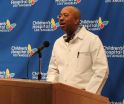(Press-News.org) Patients aged 65 and older who survive an episode of mechanical ventilation during a hospitalization are more likely to suffer from long-term disabilities after leaving the hospital than those who survive hospitalization without mechanical ventilation, according to researchers at the University of Pittsburgh. These results were borne out even though the levels of functional disability prior to hospitalization were similar in both groups.
The study was published online ahead of the print edition of the American Thoracic Society's American Journal of Respiratory and Critical Care Medicine.
"Our findings offer the first nationally-representative estimates of functional status outcomes for elderly patients who have survived mechanical ventilation, using a prospective population-based sample," said Amber Barnato, MD, associate professor of medicine, University of Pittsburgh. "Unfortunately, 70 percent of elders who receive mechanical ventilation will not survive the year. And the 30 percent who are strong enough to survive will be very disabled."
Previous studies of the effects of mechanical ventilation on elderly patients have offered conflicting results, and were limited by their local patient sampling and lack of first-person information about physical function before the illness.
"This study puts to rest the controversy: doctors can confidently tell their elderly patients that if they survive an episode of mechanical ventilation they will be much more disabled than before, and may require nursing home care," noted Dr. Barnato.
To complete their study, the researchers used data collected over a seven-year period in the Medicare Current Beneficiary Survey (MCBS), a continuous survey of a nationally representative sample of aged, disabled and institutionalized Medicare beneficiaries sponsored by the Centers for Medicare and Medicaid Services. MCBS conducts in-person interviews with each sampled beneficiary four times per year for four years, after which they rotate off the panel and new beneficiaries are invited to join. Questions related to health and functional status are asked every autumn.
For this study, the researchers linked beneficiaries' survey responses from the autumn survey with their responses one year later. Beneficiaries who were hospitalized during the 12-month period and who survived until their next autumn interview were included and divided into two groups: those who had received mechanical ventilation during hospitalization and those who had not. The researchers reviewed more than 130,000 person-years of data, from which about 12,000 person-years of data qualified for inclusion in the study.
"We restricted the study to include Medicare beneficiaries aged 65 and older who were living in the community at the time of the initial interview, and who were not enrolled in a group health plan, since these plans do not report claims data to Medicare," said Dr. Barnato. "Each beneficiary could contribute up to three years of observation during their four years of participation in the MCBS."
Researchers rated patients' pre- and post-hospitalization disability levels with regard to mobility and activities of daily living (ADL), rating patients in both areas using scores ranging from 0 (not disabled) to 100 (completely disabled).
Comparing the two groups, the researchers found those who survived mechanical ventilation experienced 30 percent greater ADL disability (14.9 vs. 11.5) and 14 percent greater mobility difficulty (25.4 vs. 22.3) than non-ventilated counterparts.
"This is especially important because the pre-hospitalization scores of the patients who were and weren't mechanically ventilated were similar," Dr. Barnato said. "Being sick enough to require mechanical ventilation, and perhaps even the experience of mechanical ventilation itself, really takes the vim and vigor out of people."
Although mechanical ventilation may be lifesaving, the possibility of prolonged disability could influence health-care decision-making, she noted.
"The greater risk of significant disability for those who survive mechanical ventilation has implications for patients' treatment goals, since Dr. Terri Fried, at Yale, has shown that many elders might not elect to receive a high-burden intervention if they knew it would result in survival with substantial disability," Dr. Barnato said.
"Clinicians should discuss outcomes that are important to patients, such as disability, as well as mortality, when working with patients and their families to make decisions about the use of mechanical ventilation," she added.
INFORMATION: END
NORFOLK, Va. – Eastern Virginia Medical School researchers have identified a potential novel treatment strategy for the social impairment of people with Autism Spectrum Disorders (ASD), an aspect of the condition that has a profound impact on quality of life.
"Persons with Autism Spectrum Disorders are either disinterested in social interactions or find them unpleasant. They often don't understand what other people are thinking or feeling and misinterpret social cues," said Stephen I. Deutsch, MD, PhD, the Ann Robinson Chair and professor of psychiatry and behavioral ...
WASHINGTON, Dec. 8 – Versatile electronic gadgets should employ a number of important criteria: small in size, quick in operation, inexpensive to fabricate, and deliver high precision output. A new microlaser, developed at the Jožef Stefan Institute in Ljubljana, Slovenia embodies all these qualities. It is small, tunable, cheap, and is essentially the world's first practical three-dimensional laser.
As described in Optics Express, an open-access journal published by the Optical Society (OSA), Slovenian scientists Matjaž Humar and Igor Muševič have developed a microdroplet ...
A peculiar gas-giant planet orbiting a sun-like star 1200 light-years away is the first carbon-rich world ever observed.
The implications are big for planetary chemistry, because without much oxygen, common rocks throughout the planet would be made of pure carbon, in forms such as diamonds or graphite.
"On most planets, oxygen is abundant. It makes rocks such as quartz and gases such as carbon dioxide," said University of Central Florida professor Joseph Harrington, one of the study's lead researchers. "With more carbon than oxygen, you would get rocks of pure carbon, ...
Sudden changes in the volume of meltwater contribute more to the acceleration – and eventual loss – of the Greenland ice sheet than the gradual increase of temperature, according to a University of British Columbia study.
The ice sheet consists of layers of compressed snow and covers roughly 80 per cent of the surface of Greenland. Since the 1990s, it has been documented to be losing approximately 100 billion tonnes of ice per year – a process that most scientists agree is accelerating, but has been poorly understood. Some of the loss has been attributed to accelerated ...
An international team of astronomers has discovered and imaged a fourth giant planet outside our solar system, a discovery that further strengthens the remarkable resemblances between a distant planetary system and our own.
The research is published Dec. 8 in the advance online version of the journal Nature.
The astronomers say the planetary system resembles a supersized version of our solar system.
"Besides having four giant planets, both systems also contain two 'debris belts' composed of small rocky or icy objects, along with lots of tiny dust particles," ...
LOS ANGELES (December 8, 2010) – Jeffrey S. Upperman, MD, director of the Trauma Program at Children's Hospital Los Angeles, has co-authored a call to action for filling a significant gap in pediatric public health care and seeks federal oversight to establish the framework for a pediatric applied trauma research network (PATRN). This call to action was published simultaneously in the Journal of Pediatric Surgery and the Journal of Trauma.
"The establishment of a pediatric trauma research network will be an important advance in trauma care in the U.S.," said Dr. Upperman. ...
Drinking cranberry juice has been recommended to decrease the incidence of urinary tract infections, based on observational studies and a few small clinical trials. However, a new study published in the January 1 issue of Clinical Infectious Diseases, and now available online (http://cid.oxfordjournals.org/content/52/1/23.full), suggests otherwise.
College-aged women who tested positive for having a urinary tract infection were assigned to drink eight ounces of cranberry juice or a placebo twice a day for either six months or until a recurrence of a urinary tract infection, ...
Diving blue whales can dive for anything up to 15 minutes. However, Bob Shadwick from the University of British Columbia, Canada, explains that blue whales may be able to dive for longer, because of the colossal oxygen supplies they could carry in their blood and muscles, so why don't they? 'The theory was that what they are doing under water must use a lot of energy,' says Shadwick. Explaining that the whales feed by lunging repeatedly through deep shoals of krill, engulfing their own body weight in water before filtering out the nutritious crustaceans, Shadwick says, ...
BLOOMINGTON, Ind. -- A new study by sexual health researchers at Indiana University found that women who used lubricant during sex reported significantly higher levels of satisfaction and pleasure.
The study, involving 2,453 women, is the largest systematic study of this kind, despite the widespread commercial availability of lubricant and the gaps in knowledge concerning its role in alleviating pain or contributing to other health issues.
"In spite of the widespread availability of lubricants in stores and on the Internet, it is striking how little research addresses ...
CAMBRIDGE, Mass., Dec. 9, 2010 -- The centuries-old "one-drop rule" assigning minority status to mixed-race individuals appears to live on in our modern-day perception and categorization of people like Barack Obama, Tiger Woods, and Halle Berry.
So say Harvard University psychologists, who've found that we still tend to see biracials not as equal members of both parent groups, but as belonging more to their minority parent group. Their research appears in the Journal of Personality and Social Psychology.
"Many commentators have argued that the election of Barack Obama, ...

